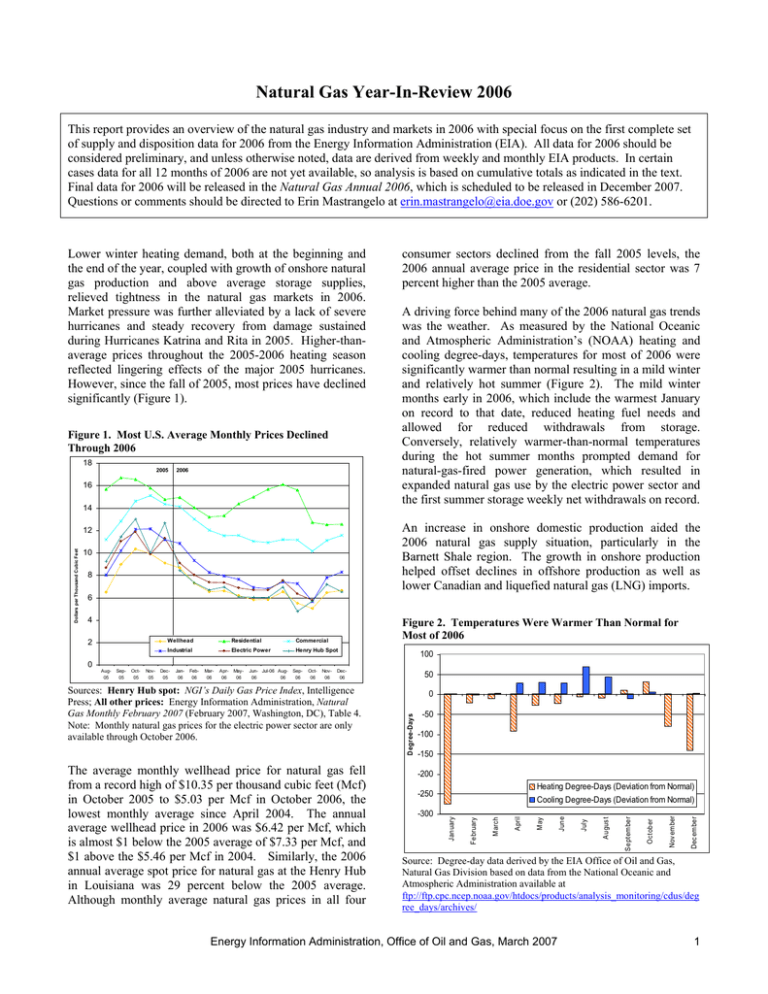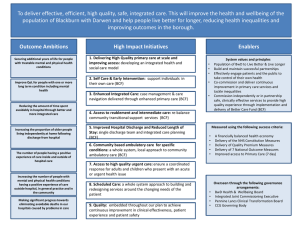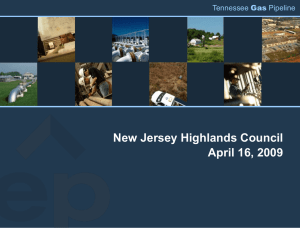Natural Gas Year-In-Review 2006
advertisement

Natural Gas Year-In-Review 2006 This report provides an overview of the natural gas industry and markets in 2006 with special focus on the first complete set of supply and disposition data for 2006 from the Energy Information Administration (EIA). All data for 2006 should be considered preliminary, and unless otherwise noted, data are derived from weekly and monthly EIA products. In certain cases data for all 12 months of 2006 are not yet available, so analysis is based on cumulative totals as indicated in the text. Final data for 2006 will be released in the Natural Gas Annual 2006, which is scheduled to be released in December 2007. Questions or comments should be directed to Erin Mastrangelo at erin.mastrangelo@eia.doe.gov or (202) 586-6201. Lower winter heating demand, both at the beginning and the end of the year, coupled with growth of onshore natural gas production and above average storage supplies, relieved tightness in the natural gas markets in 2006. Market pressure was further alleviated by a lack of severe hurricanes and steady recovery from damage sustained during Hurricanes Katrina and Rita in 2005. Higher-thanaverage prices throughout the 2005-2006 heating season reflected lingering effects of the major 2005 hurricanes. However, since the fall of 2005, most prices have declined significantly (Figure 1). Figure 1. Most U.S. Average Monthly Prices Declined Through 2006 18 2005 2006 16 14 A driving force behind many of the 2006 natural gas trends was the weather. As measured by the National Oceanic and Atmospheric Administration’s (NOAA) heating and cooling degree-days, temperatures for most of 2006 were significantly warmer than normal resulting in a mild winter and relatively hot summer (Figure 2). The mild winter months early in 2006, which include the warmest January on record to that date, reduced heating fuel needs and allowed for reduced withdrawals from storage. Conversely, relatively warmer-than-normal temperatures during the hot summer months prompted demand for natural-gas-fired power generation, which resulted in expanded natural gas use by the electric power sector and the first summer storage weekly net withdrawals on record. An increase in onshore domestic production aided the 2006 natural gas supply situation, particularly in the Barnett Shale region. The growth in onshore production helped offset declines in offshore production as well as lower Canadian and liquefied natural gas (LNG) imports. 12 Dollars per Thousand Cubic Feet consumer sectors declined from the fall 2005 levels, the 2006 annual average price in the residential sector was 7 percent higher than the 2005 average. 10 8 6 4 2 Figure 2. Temperatures Were Warmer Than Normal for Most of 2006 Wellhead Residential Commercial Industrial Electric Power Henry Hub Spot 100 0 Nov06 Dec06 Sources: Henry Hub spot: NGI’s Daily Gas Price Index, Intelligence Press; All other prices: Energy Information Administration, Natural Gas Monthly February 2007 (February 2007, Washington, DC), Table 4. Note: Monthly natural gas prices for the electric power sector are only available through October 2006. The average monthly wellhead price for natural gas fell from a record high of $10.35 per thousand cubic feet (Mcf) in October 2005 to $5.03 per Mcf in October 2006, the lowest monthly average since April 2004. The annual average wellhead price in 2006 was $6.42 per Mcf, which is almost $1 below the 2005 average of $7.33 per Mcf, and $1 above the $5.46 per Mcf in 2004. Similarly, the 2006 annual average spot price for natural gas at the Henry Hub in Louisiana was 29 percent below the 2005 average. Although monthly average natural gas prices in all four 50 0 -50 -100 -150 -200 Heating Degree-Days (Deviation from Normal) -250 -300 Cooling Degree-Days (Deviation from Normal) December Oct06 November Sep06 October Jun- Jul-06 Aug06 06 September May06 August Apr06 July Mar06 June Feb06 May Jan06 April Dec05 March Nov05 February Oct05 January Sep05 Degree-Days Aug05 Source: Degree-day data derived by the EIA Office of Oil and Gas, Natural Gas Division based on data from the National Oceanic and Atmospheric Administration available at ftp://ftp.cpc.ncep.noaa.gov/htdocs/products/analysis_monitoring/cdus/deg ree_days/archives/ Energy Information Administration, Office of Oil and Gas, March 2007 1 Total Consumption Declined Despite Increased Electric Power Consumption Increases in natural gas consumption by the electric power sector were offset by declines in each of the remaining three end-use sectors (Figure 3). Total consumption for all four major end-use sectors declined by almost 2 percent to 21.86 trillion cubic feet (Tcf) in 2006, the lowest level the United States has seen since 1994. The relatively small decline, however, does not reflect the disparity between the end-use sectors. The residential sector consumed over 9 percent less natural gas in 2006 than in 2005. Likewise, the commercial and industrial sectors consumed 6 percent and 2 percent less, respectively, than in 2005. The electric power sector, however, offset much of the decline by consuming over 6 percent more natural gas than in the previous year. Figure 3. Annual Natural Gas Consumption Declined in 2006 in all Sectors Except for Electric Power 8.0 7.0 Trillion Cubic Feet 6.0 5.0 4.0 3.0 2.0 capacity and increased that figure by another 7,822 in the first 11 months of 2006. Lastly, the decrease in natural gas prices paid by the electric power sector likely contributed to increased consumption levels in 2006. Since the fall of 2005, the average monthly price decreased from a record high of $11.85 per Mcf in October 2005 to $5.75 per Mcf in October 2006. Residential Consumption Experiences Significant Declines The warmer-than-normal temperatures throughout most of 2006 contributed to significant declines in residential consumption by keeping demand for natural gas space heating low. According to NOAA, temperatures in January were between 12 and 42 percent warmer than normal in every Census Division of the United States and 28 percent warmer than normal for the country as a whole. In January 2006, residential consumption was around 712 billion cubic feet (Bcf), which is 20 percent less than January 2005 and the lowest January level in more than 30 years. Residential consumers continued this decreasing trend throughout much of 2006 as monthly consumption through August was between 4 and 17 percent less than the corresponding months in 2005. The decrease in residential consumption also reflects elevated prices in this sector. Although the residential price has decreased since the September 2005 record high of $16.70 per Mcf, the average annual 2006 price increased to $13.76 per Mcf, 7 percent higher than the previous record high set in 2005. 1.0 0.0 2001 2002 Residential 2003 Commercial 2004 Industrial 2005 Production Grew Despite Lingering Impacts of Hurricanes Katrina and Rita 2006 Electric Power Sources: 2001-2005: Energy Information Administration, Natural Gas Annual 2005 (November 2006, Washington, DC), Table 1; 2006: Energy Information Administration, Natural Gas Monthly February 2007 (February 2007, Washington, DC), Table 3. Electric Power Sector Exhibits Demand Strength In contrast to the residential, industrial, and commercial end-use sectors, relatively hot summer months increased natural gas demand from the electric power sector for the third straight year. While January consumption levels in the electric power sector were at their lowest levels since before 2001, consumption during most of the remaining months of 2006 was between 1 and 22 percent more than the corresponding months of 2005. This resulted in an overall increase of 6 percent over 2005. Since 2003, electric power consumption has increased by 22 percent, highlighting the growing contribution of this sector to natural gas demand. Along with warmer weather, the addition of natural-gas-fired generation in recent years may have aided the surge in demand. In 2005, the United States added 12,577 megawatts of natural gas net summer Total marketed production in 2006 increased by about 2 percent to 19.34 Tcf, despite significant declines in production from the Federal offshore Gulf of Mexico. Although production from this region has been declining by as much as 10 percent per year between 2002 and 2004, Hurricanes Katrina and Rita in the fall of 2005 imposed severe supply disruptions in the Gulf of Mexico which exacerbated production declines. As a result, production in this region, which usually accounts for over 20 percent of annual domestic marketed production, dropped 21 percent in 2005. As of October 2006, Federal offshore Gulf of Mexico production in 2006 was 2.37 Tcf, which is a decline of 13 percent from the corresponding period in 2005. 1 This volume accounted for only 15 percent of cumulative domestic marketed production for January through October 2006. 1 Regional production data for 2006 reflects January through October levels compared with the equivalent timeframe in previous years. Energy Information Administration, Office of Oil and Gas, March 2007 2 In August and September of 2005, the U.S. Gulf Coast was hit by two of the most severe hurricanes in recent history. The storms devastated much of coastal Alabama, Louisiana, and Mississippi, including extensive damage to natural gas infrastructure. Hurricane Katrina destroyed 44 platforms in the Gulf of Mexico and damaged 20 others, while Hurricane Rita destroyed 69 platforms and damaged 32 others. In addition, up to 75 percent of the natural gas processing capacity in the region was shut in when threatened by Hurricane Rita. Not all capacity came back online promptly after the hurricanes because of damage to the plants. In fact, the damage at Grand Chenier was so extensive that in January it was announced that the plant was being decommissioned. The last reopening of a damaged gas processing plant occurred in April 2006. The Minerals Management Service (MMS) reported final shutin statistics in June 2006, estimating that almost 1 Bcf per day of natural gas production in the Federal Gulf of Mexico remained shut in. The 1 Bcf figure represents about 9 percent of daily production in the region and 5 percent of the U.S. total. Cumulative shut-in natural gas production from August 26, 2005, through June 19, 2006, totaled 803.6 Bcf, which is equivalent to about 22 percent of annual production in the Federal Gulf of Mexico and about 4 percent of annual U.S. natural gas production. Higher Drilling Rates Yield Growing Production from Onshore Regions As of October 2006, marketed production of natural gas outside the Federal Gulf of Mexico in 2006 was 13.68 Tcf, which is over 4 percent more than the level for the equivalent time frame of 2005. The growing production from onshore regions occurred as drilling rates reached record heights. According to Baker Hughes Incorporated, the weekly number of U.S. rigs drilling for natural gas, onshore and offshore, hit a new high in 2006 at 1,450 rigs. This occurred during the week ending September 22, 2006, and again during the week ending October 27, 2006 (Figure 4). In January 2006, there were around 1,226 rigs drilling for natural gas on average, an increase of roughly 14 percent above the January 2005 average and almost 40 percent more than the January 2001 average. A vast majority of these rigs are onshore, and moreover, while the number of onshore rigs has been significantly increasing in recent years, the number of rigs drilling for natural gas offshore has decreased. In late December 2006, there were 81 natural gas rigs in the Gulf of Mexico which is well below the record number of 134 that were engaged during July and August of 2000. Figure 4. Weekly Natural Gas Rig Count Increased Dramatically in 2006 1,500 1,450 Number of Rigs Drilling for Natural Gas Effects of Hurricanes Katrina and Rita. Record Number: 1450 (week ending 9/22 and 10/27) 1,400 1,350 1,300 1,250 1,200 1,150 1,100 1,050 0 136827- 24- 24- 21- 19- 16- 14- 11Jan- Feb- Mar- Apr- May- Jun- Jul-06 Aug- Sep- Oct- Nov- Dec06 06 06 06 06 06 06 06 06 06 06 Week ending Source: Baker Hughes Incorporated, North American Rotary Rig Count, available at http://www.bakerhughes.com/investor/rig/rig_na.htm Largest Onshore Production Increases Predominantly in Top Producing States Occurred Although many producing States recorded increases in production in 2006, a majority of the overall increase came from the top three producing States: Texas, Oklahoma, and Wyoming (Figure 5). Together, increased production from these three States represents almost 73 percent of the total increase. The largest producing State, Texas, increased onshore production by 259 Bcf, or about 5 percent, in the first 10 months of 2006, which accounts for about 46 percent of the overall increase. 2 This is partially attributable to activity in the Barnett Shale oil and natural gas play in North Texas. Since the late-1990s, advances in technology have increased the economic viability of oil and natural gas reserves in this region. In 2006, there was an average of 133 rigs drilling for oil and natural gas in Texas District 5 where the Barnett Shale is located. This is 53 more rigs than the average in 2005, and this increase represents 20 percent of the yearly increase in total average U.S. rigs. In addition to Texas, production increases in Oklahoma and Wyoming were also noteworthy at about 5 percent each. Both of these States produced more natural gas in the first 10 months of 2006 than in comparable timeframes of recent years. 2 Estimates of Texas natural gas production were adjusted in 2004 to correctly account for carbon dioxide production. The 2001-2003 estimates were not adjusted and include nonindigenous carbon dioxide. Energy Information Administration, Office of Oil and Gas, March 2007 3 Figure 5. Increased Marketed Production from the 4 of the Top 5 Producing States Offset Decreases in the Federal Gulf of Mexico (Jan-Oct, 2001-2006) 5 Total U.S. Natural Gas Marketed Production 4.5 Tcf Year 2001………20.57 2002….…...19.88 2003………19.97 2004……….19.52 2005………18.95 2006……….19.34 Trillion Cubic Feet (Tcf) 4 3.5 3 2.5 2 1.5 1 0.5 0 Texas Oklahoma 2001 Wyoming 2002 2003 New Mexico 2004 2005 Louisiana Federal GOM 2006 Sources: 2001-2005: Energy Information Administration, Natural Gas Annual 2005 (November 2006, Washington, DC), Table 3; 2006: Energy Information Administration, Natural Gas Monthly February 2007 (February 2007, Washington, DC), Table 7. Working Gas in Storage Exceeded Previous 5-Year Levels Throughout All of 2006 The increase in domestic production along with lower demands for heating set the stage for relatively abundant natural gas in storage for all of 2006. Working gas began the year at relatively high levels and continued to exceed the monthly inventories for each of the previous 5 years (Figure 6). The high storage levels reflected reduced tightness in the market, which led to the overall decrease in natural gas prices for much of 2006. However, prices likely influenced storage levels as well. The spot price remained in contango with the New York Mercantile Exchange futures prices for delivery during the 2006-2007 heating season for almost every 2006 trading day. When futures prices are higher than current spot prices, there is an economic incentive to keep natural gas in storage. Figure 6. 2006 End-of-Month Working Gas Stocks Exceeded Volumes of Previous 5 Years Offshore Leasing Ban Lifted in Areas of Gulf of Mexico and North Aleutian Basin 4,000 3,500 Billion Cubic Feet 3,000 2,500 2,000 1,500 1,000 500 2000 2001 2002 2003 2004 2005 December November October September August July June May April March February 0 January In December 2006, President Bush signed the Gulf of Mexico Energy Security Act of 2006, which requires oil and natural gas leasing in two areas of the Central Gulf of Mexico: the Sale 181 Area and the 181 South Area. Because the 181 South Area was under a leasing ban until 2012, the President subsequently issued a memorandum in January 2007 that lifted restrictions on oil and natural gas leasing in this region. The memorandum also lifts similar restrictions on Bristol Bay in the North Aleutian Basin of Alaska. The 181 South Area and Bristol Bay were previously withdrawn from consideration for leasing through 2012 by a Presidential directive issued in 1998 by President Clinton. President Bush modified the Presidential withdrawal in order to give the MMS the option to offer these two areas as part of the next 5-year leasing program (2007-2012). The 181 South Area covers about 5.8 million acres in the Central Gulf of Mexico Planning Area and contains an estimated 2.16 trillion cubic feet of technically recoverable, undiscovered natural gas and 0.52 billion barrels of oil. Both this area and an additional 2 million acres covered in the Sale 181 Area were included in the 2007-2012 proposed leasing program. The North Aleutian Basin covers about 5.6 million acres offshore Alaska and contains an estimated 23.38 trillion cubic feet of technically recoverable, undiscovered natural gas resources and about 2.5 billion barrels of oil resources. 2006 Sources: 2000: Energy Information Administration, Natural Gas Monthly February 2003 (February 2003, Washington, DC), Table 9; 2001-2003: Energy Information Administration, Natural Gas Monthly February 2004 (February 2004, Washington, DC), Table 9; 2004-2006: Energy Information Administration, Natural Gas Monthly February 2007 (February 2007, Washington, DC), Table 9. Limited Withdrawals and Low Injections Characterized Storage Activity Although storage stocks were at unusually high levels, injections and withdrawals during the year were well below volumes recorded in recent years. The record warm January followed by an unusually warm February limited the amount of withdrawals during the 2005-2006 heating season. This was underscored by the first ever weekly net injection recorded during a winter season, which measured 1 Bcf for the week ending December 29, 2005. Because of the limited withdrawals, storage at the end of the heating season, on March 31, 2006, was 1,692 Bcf, the highest level for this date since 1991. With higher-than-normal stocks going into the refill season coupled with a surge in Energy Information Administration, Office of Oil and Gas, March 2007 4 Figure 8. U.S. Imports Declined in 2006 for the First Time Since 2003 20 18 16 Billion Cubic Feet per Day summer cooling load demand, injections of natural gas during the refill season of 2006 were particularly low, including the first recorded weekly net withdrawals during the warmer months of May through September. This occurred during the weeks ending July 21, 2006, and August 4, 2006. Between April and October 2006, net injections were 1,761 Bcf, which is well below the average of 2,111 Bcf during the previous 5 years. Despite the low injections, however, working gas stocks at the start of the 2006-2007 heating season were 3,452 Bcf, which is the highest level since 1990 (Figure 7). 14 12 10 8 6 U.S. Imports from Canada 4 Figure 7. Working Gas Volumes at the Beginning of the Heating Season Increased in 2006 Despite Relatively Low Net Injections 0 1996 1997 1998 1999 2000 2001 2002 2003 2004 2005 2006 Sources: Production-1996 to 2005: Canadian Association of Petroleum Producers; 2006, EIA Office of Oil and Gas, Natural Gas Division estimate. U.S. Imports: Energy Information Administration. 3,500 3,000 Billion Cubic Feet (Bcf) 2 2,500 Imports from Canada Declined for the First Time in 3 Years 2,000 1,500 1,000 500 0 1990 1992 1994 1996 1998 End of Heating Season Stocks 2000 2002 2004 2006 Net Injections During Refill Season Sources: 1990-2004: Energy Information Administration, Natural Gas Monthly, many editions February 1992 – February 2006 (February 1992 – February 2006, Washington, DC), Table 9; 2005-2006: Energy Information Administration, Natural Gas Monthly February 2007 (February 2007, Washington, DC), Table 9. Growth in imports from Canada in 2004 and 2005 stalled in 2006, resulting in overall deliveries of 3,598 Bcf, or 103 Bcf less than the previous year. In almost every month in 2006, imports from Canada were below the previous year’s levels as less natural gas was available for export from Canada despite slightly more production. However, Canada continued to be the source for the largest volumes of natural gas imported to the United States, accounting for 86 percent of gross receipts of foreign natural gas. Volumes of LNG and the Diversity of LNG Sources Down Both Pipeline and LNG Net Imports Declined The net volume of natural gas imports decreased 5 percent from 2005 to 2006, as volumes of both pipeline imports from Canada and LNG imports from various countries declined. In terms of net volume, the United States in 2006 received 3,433 Bcf, or 179 Bcf less than it received in 2005. The decrease was primarily due to a 154 Bcf decline in gross imports, including a decline of 103 Bcf from Canada, 3 Bcf from Mexico, and a 48 Bcf decline in LNG supplies. Net imports of natural gas to the United States have risen substantially since the mid-1980s, when pipeline imports from Canada began a dramatic increase. However, this trend of growing net imports has temporarily stalled in the last several years as growth of imports from Canada has leveled off (Figure 8). LNG imports have also declined slightly in the last couple years, although they are forecast to increase substantially in coming years. In 2006, net imports were about 15.7 percent of overall U.S. natural gas consumption. In 2006, the United States imported the equivalent of 584 Bcf, which is about 8 percent lower than the 631 Bcf received in 2005 and 10 percent lower than peak receipts of 652 Bcf in 2004. LNG imports to the United States were from a mix of source countries: Trinidad and Tobago (66.7 percent), Egypt (20.4 percent), Nigeria (9.8 percent), and Algeria (3.0 percent). However, the number of source countries providing LNG imports during to the United States in 2006 was considerably less than in previous years when shipments were received from countries in the Middle East and the Pacific Basin (Figure 9). Although global liquefaction capacity has increased considerably since 2005 as the result of capacity additions in Egypt, Trinidad and Tobago, Nigeria, and other countries, maintenance delays and lack of available feedstock gas caused LNG production to grow at a much lower rate. At the same time, there has been strong demand for LNG in countries other than the United States, such as Spain, France, Belgium, and the United Kingdom. Energy Information Administration, Office of Oil and Gas, March 2007 5 LNG traders with options to deliver to multiple destinations found higher prices, and more attractive markets, in Europe and Asia compared to the United States. As a result, U.S. imports of LNG were depressed for most of 2006. The four active onshore regasification terminals in the United States received generally similar volumes of LNG imports in 2006, each importing between 20 and 30 percent of the total. These onshore facilities are located in Everett, Massachusetts; Lake Charles, Louisiana; Elba Island, Georgia; and Cove Point, Maryland. The lone offshore facility, Gulf Gateway, in the Gulf of Mexico only received one shipment of LNG. Of the four onshore regasification terminals, Trunkline LNG facility in Lake Charles had the lowest utilization rate an average of about 25 percent during the year, compared to 66 percent for the Everett terminal, 33 percent for the Elba Island terminal, and 32 percent for the Cove Point terminal. Figure 9. The United States Received LNG from Four Countries in 2006 700 600 44 percent in 2006. This increase in construction activity was primarily driven by the needs of natural gas producers located in the Rocky Mountain States of Colorado and Wyoming and in the Barnett Shale area of northeast Texas. The continuing development of new natural gas supplies in these two regions has increased the need for additional natural gas pipeline transportation capacity from these areas to Northeast and Midwest regional markets. Almost half, 21, of the 45 natural gas pipeline projects completed in the United States during the year were located in these two areas. Projects completed in the Rocky Mountain area accounted for 26 percent of all new natural gas pipeline capacity (3.2 Bcf/d) installed during the year, while those completed in the northeast Texas area constituted another 25 percent (3.1 Bcf/d). Elsewhere in the country, the installation of new capacity and pipeline mileage in the Gulf of Mexico took a significant leap with the completion of 3 medium-to-large capacity deep water projects representing 2.4 Bcf/d of new capacity and 192 miles of new pipeline. The largest of these was the 1-Bcf/d, 140-mile, Independence Trail system, which extends from the West Delta area of the Gulf to an offshore interconnection with the Tennessee Gas Pipeline Company system. Billion Cubic Feet 500 400 FERC Approves Millennium Pipeline Project 300 200 100 0 1996 1997 1998 1999 Trinidad and Tobago 2000 2001 Algeria 2002 Egypt 2003 2004 East of Suez 2005 2006 Nigeria Note: East of Suez may include the following countries: United Arab Emirates, Australia, Brunei, Indonesia, Malaysia, Oman, and Qatar. Source: EIA Office of Oil and Gas, Natural Gas Division, based on data from the Department of Energy, Office of Fossil Energy. Greater Additions to Pipeline Capacity and Mileage in 2006 Driven By Rockies and Barnett Shale The addition of 12.3 Bcf per day (Bcf/d) of new natural gas pipeline capacity in the United States in 2006 was 50 percent greater than the 8.2 Bcf/d which occurred in 2005. Moreover, the addition of new pipeline mileage grew by The year 2006 was a noteworthy year in natural gas transportation for the Northeast. Almost a decade after it was first proposed, the Millennium Pipeline Project received approval on December 22, 2006, from the Federal Energy Regulatory Commission (FERC) to construct the 187-mile Millennium pipeline. Extending from Corning, New York, across the southern tier of New York State to Ramapo, New York, the Millennium Pipeline will serve markets along its route in the Southern Tier and lower Hudson Valley, as well as provide service to the New York City markets through its pipeline interconnections. Millennium, which is one link of the larger “NE 07 Project” will transport up to 525 billion British thermal units per day (509 Bcf/d) to these growing markets. FERC conditionally approved the project after review of a final Supplemental Environmental Impact Statement. If Millennium Pipeline Company agrees to all of the conditions required for final approval, the pipeline is planned to be in service by November 2008. Energy Information Administration, Office of Oil and Gas, March 2007 6





